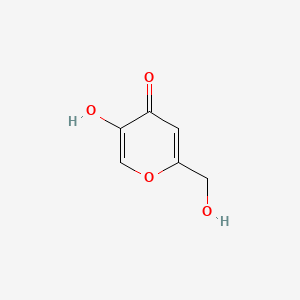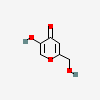Kojic acid
- kojic acid
- 501-30-4
- 5-Hydroxy-2-(hydroxymethyl)-4H-pyran-4-one
- 5-Hydroxy-2-(hydroxymethyl)-4-pyrone
- 4H-PYRAN-4-ONE, 5-HYDROXY-2-(HYDROXYMETHYL)-
- Create:2005-03-25
- Modify:2025-01-11

- 5-((3-aminopropyl)phosphinooxy)-2-(hydroxymethyl)-4H-pyran-4-one
- kojic acid
- kojyl-APPA
- kojic acid
- 501-30-4
- 5-Hydroxy-2-(hydroxymethyl)-4H-pyran-4-one
- 5-Hydroxy-2-(hydroxymethyl)-4-pyrone
- 4H-PYRAN-4-ONE, 5-HYDROXY-2-(HYDROXYMETHYL)-
- 5-hydroxy-2-(hydroxymethyl)pyran-4-one
- 5-Hydroxy-2-hydroxymethyl-4-pyrone
- acido kojico
- 2-Hydroxymethyl-5-hydroxy-gamma-pyrone
- MFCD00006580
- Kojisaeure
- CCRIS 4131
- 2-(Hydroxymethyl)-5-hydroxy-4H-pyran-4-one
- NSC 1942
- EINECS 207-922-4
- UNII-6K23F1TT52
- BRN 0120895
- 5-Hydroxy-2-hydroxymethyl-4H-4-pyranone
- DTXSID2040236
- CHEBI:43572
- AI3-02549
- HSDB 7664
- Pyran-4-one, 5-hydroxy-2-(hydroxymethyl)
- 6K23F1TT52
- NSC-1942
- 123712-78-7
- 5-Hydroxy-2-hydroxymethyl-pyran-4-one
- 5-Hydroxy-2-hydroxymethyl-4H-pyran-4-one
- CHEMBL287556
- DTXCID0020236
- NSC1942
- 5-18-02-00516 (Beilstein Handbook Reference)
- NCGC00017325-03
- NCGC00017325-06
- KOJIC ACID (IARC)
- KOJIC ACID [IARC]
- KOJIC ACID (MART.)
- KOJIC ACID [MART.]
- CAS-501-30-4
- Kojic acid (Standard)
- Spectrum_000191
- KOJIC ACID [MI]
- Spectrum2_001828
- Spectrum3_001704
- Spectrum4_000571
- Spectrum5_001085
- Natural Kojic Acid Powder
- KOJIC ACID [HSDB]
- Oprea1_038773
- SCHEMBL36895
- BSPBio_003288
- KBioGR_001002
- KBioSS_000671
- KOJIC ACID [WHO-DD]
- BIDD:ER0501
- DivK1c_000923
- SPBio_001875
- Kojic acid, analytical standard
- MEGxm0_000388
- WLN: T6O DVJ B1Q EQ
- ACon1_000622
- BEJNERDRQOWKJM-UHFFFAOYSA-
- HMS502O05
- KBio1_000923
- KBio2_000671
- KBio2_003239
- KBio2_005807
- KBio3_002508
- NINDS_000923
- HMS3604L04
- KUC106760N
- HY-W050154R
- TNP00261
- 2-Hydroxymethyl-5-hydroxy-?-pyrone
- Tox21_110814
- Tox21_113449
- BBL010645
- BDBM50031467
- CCG-38458
- s5174
- STK801688
- AKOS000120649
- Tox21_110814_1
- 5-Hydroxy-2-hydroxymethyl-I(3)-pyron
- DB01759
- HY-W050154
- IDI1_000923
- SMP1_000171
- NCGC00017325-01
- NCGC00017325-02
- NCGC00017325-04
- NCGC00017325-05
- NCGC00017325-10
- NCGC00142361-01
- NCGC00168903-01
- NCGC00168903-02
- NCGC00181145-01
- AC-11658
- AS-11648
- Kojic acid, purum, >=98.0% (HPLC)
- KSC-11-228-2
- SY018009
- 2-Hydroxymethyl-5-hydroxy-4H-pyran-4-one
- CS-0032701
- K0010
- K0012
- NS00013805
- EN300-20919
- C91105
- K-7000
- 2-HYDROXYMETHYL-5-HYDROXY-.GAMMA.-PYRONE
- AN-584/40205787
- Q416285
- SR-01000945134
- SR-01000945134-1
- C65A72E0-0E46-4AF4-AA68-178ECA2E5FCC
- F0001-1307
- Z104484860
- InChI=1/C6H6O4/c7-2-4-1-5(8)6(9)3-10-4/h1,3,7,9H,2H2
142.0 99.99
69.0 74
29.0 53
39.0 40
113.0 36
142.0 99.99
69.0 72
29.0 52
39.0 40
113.0 34
141.0187 100
111.0091 13.98
113.0238 13.44
84.889112 5.91
82.863063 4.43
112.892554 2.66
68.887761 1.74
96.865712 1.46
143.0339 999
69.0335 85
97.0284 77
143.0339 999
69.0335 81
97.0284 73
142 999
69 740
29 530
39 400
113 360
- Cytoplasm
- Extracellular

P203, P280, P318, P405, and P501
(The corresponding statement to each P-code can be found at the GHS Classification page.)
Aggregated GHS information provided per 79 reports by companies from 4 notifications to the ECHA C&L Inventory.
Reported as not meeting GHS hazard criteria per 69 of 79 reports by companies. For more detailed information, please visit ECHA C&L website.
There are 2 notifications provided by 10 of 79 reports by companies with hazard statement code(s).
Information may vary between notifications depending on impurities, additives, and other factors. The percentage value in parenthesis indicates the notified classification ratio from companies that provide hazard codes. Only hazard codes with percentage values above 10% are shown.
Patents are available for this chemical structure:
https://patentscope.wipo.int/search/en/result.jsf?inchikey=BEJNERDRQOWKJM-UHFFFAOYSA-N
- BindingDBLICENSEAll data curated by BindingDB staff are provided under the Creative Commons Attribution 3.0 License (https://creativecommons.org/licenses/by/3.0/us/).https://www.bindingdb.org/rwd/bind/info.jsp5-HYDROXY-2-(HYDROXYMETHYL)-4H-PYRAN-4-ONEhttps://www.bindingdb.org/rwd/bind/chemsearch/marvin/MolStructure.jsp?monomerid=50031467
- Comparative Toxicogenomics Database (CTD)LICENSEIt is to be used only for research and educational purposes. Any reproduction or use for commercial purpose is prohibited without the prior express written permission of NC State University.http://ctdbase.org/about/legal.jsp
- Drug Gene Interaction database (DGIdb)LICENSEThe data used in DGIdb is all open access and where possible made available as raw data dumps in the downloads section.http://www.dgidb.org/downloads
- Therapeutic Target Database (TTD)
- Toxin and Toxin Target Database (T3DB)LICENSET3DB is offered to the public as a freely available resource. Use and re-distribution of the data, in whole or in part, for commercial purposes requires explicit permission of the authors and explicit acknowledgment of the source material (T3DB) and the original publication.http://www.t3db.ca/downloadsKojic acidhttp://www.t3db.ca/toxins/T3D3769
- CAS Common ChemistryLICENSEThe data from CAS Common Chemistry is provided under a CC-BY-NC 4.0 license, unless otherwise stated.https://creativecommons.org/licenses/by-nc/4.0/
- ChemIDplusChemIDplus Chemical Information Classificationhttps://pubchem.ncbi.nlm.nih.gov/source/ChemIDplus
- DrugBankLICENSECreative Common's Attribution-NonCommercial 4.0 International License (http://creativecommons.org/licenses/by-nc/4.0/legalcode)https://www.drugbank.ca/legal/terms_of_useKojic acidhttps://www.drugbank.ca/drugs/DB01759
- DTP/NCILICENSEUnless otherwise indicated, all text within NCI products is free of copyright and may be reused without our permission. Credit the National Cancer Institute as the source.https://www.cancer.gov/policies/copyright-reuse
- EPA DSSToxCompTox Chemicals Dashboard Chemical Listshttps://comptox.epa.gov/dashboard/chemical-lists/
- European Chemicals Agency (ECHA)LICENSEUse of the information, documents and data from the ECHA website is subject to the terms and conditions of this Legal Notice, and subject to other binding limitations provided for under applicable law, the information, documents and data made available on the ECHA website may be reproduced, distributed and/or used, totally or in part, for non-commercial purposes provided that ECHA is acknowledged as the source: "Source: European Chemicals Agency, http://echa.europa.eu/". Such acknowledgement must be included in each copy of the material. ECHA permits and encourages organisations and individuals to create links to the ECHA website under the following cumulative conditions: Links can only be made to webpages that provide a link to the Legal Notice page.https://echa.europa.eu/web/guest/legal-notice5-hydroxy-2-hydroxymethyl-4-pyronehttps://echa.europa.eu/substance-information/-/substanceinfo/100.007.2035-hydroxy-2-hydroxymethyl-4-pyrone (EC: 207-922-4)https://echa.europa.eu/information-on-chemicals/cl-inventory-database/-/discli/details/125901
- FDA Global Substance Registration System (GSRS)LICENSEUnless otherwise noted, the contents of the FDA website (www.fda.gov), both text and graphics, are not copyrighted. They are in the public domain and may be republished, reprinted and otherwise used freely by anyone without the need to obtain permission from FDA. Credit to the U.S. Food and Drug Administration as the source is appreciated but not required.https://www.fda.gov/about-fda/about-website/website-policies#linking
- Hazardous Substances Data Bank (HSDB)
- Human Metabolome Database (HMDB)LICENSEHMDB is offered to the public as a freely available resource. Use and re-distribution of the data, in whole or in part, for commercial purposes requires explicit permission of the authors and explicit acknowledgment of the source material (HMDB) and the original publication (see the HMDB citing page). We ask that users who download significant portions of the database cite the HMDB paper in any resulting publications.http://www.hmdb.ca/citingHMDB0032923_cms_27461https://hmdb.ca/metabolites/HMDB0032923#spectra
- New Zealand Environmental Protection Authority (EPA)LICENSEThis work is licensed under the Creative Commons Attribution-ShareAlike 4.0 International licence.https://www.epa.govt.nz/about-this-site/general-copyright-statement/4H-Pyran-4-one, 5-hydroxy-2-(hydroxymethyl)-https://www.epa.govt.nz/industry-areas/hazardous-substances/guidance-for-importers-and-manufacturers/hazardous-substances-databases/
- CCSbaseCCSbase Classificationhttps://ccsbase.net/
- ChEBI
- LOTUS - the natural products occurrence databaseLICENSEThe code for LOTUS is released under the GNU General Public License v3.0.https://lotus.nprod.net/Kojic acidhttps://www.wikidata.org/wiki/Q416285LOTUS Treehttps://lotus.naturalproducts.net/
- ChEMBLLICENSEAccess to the web interface of ChEMBL is made under the EBI's Terms of Use (http://www.ebi.ac.uk/Information/termsofuse.html). The ChEMBL data is made available on a Creative Commons Attribution-Share Alike 3.0 Unported License (http://creativecommons.org/licenses/by-sa/3.0/).http://www.ebi.ac.uk/Information/termsofuse.htmlChEMBL Protein Target Treehttps://www.ebi.ac.uk/chembl/g/#browse/targets
- ClinicalTrials.govLICENSEThe ClinicalTrials.gov data carry an international copyright outside the United States and its Territories or Possessions. Some ClinicalTrials.gov data may be subject to the copyright of third parties; you should consult these entities for any additional terms of use.https://clinicaltrials.gov/ct2/about-site/terms-conditions#Use
- Cosmetic Ingredient Review (CIR)
- EPA Chemical and Products Database (CPDat)EPA CPDat Classificationhttps://www.epa.gov/chemical-research/chemical-and-products-database-cpdat
- NORMAN Suspect List ExchangeLICENSEData: CC-BY 4.0; Code (hosted by ECI, LCSB): Artistic-2.0https://creativecommons.org/licenses/by/4.0/Kojic acidNORMAN Suspect List Exchange Classificationhttps://www.norman-network.com/nds/SLE/
- DailyMed
- MassBank Europe
- MassBank of North America (MoNA)LICENSEThe content of the MoNA database is licensed under CC BY 4.0.https://mona.fiehnlab.ucdavis.edu/documentation/license
- NMRShiftDB
- NIST Mass Spectrometry Data CenterLICENSEData covered by the Standard Reference Data Act of 1968 as amended.https://www.nist.gov/srd/public-law4H-Pyran-4-one, 5-hydroxy-2-(hydroxymethyl)-http://www.nist.gov/srd/nist1a.cfm
- SpectraBase5-HYDROXY-2-HYDROXYMETHYLPYRAN-4-ONEhttps://spectrabase.com/spectrum/DzgqlgiVAWs5-HYDROXY-2-(HYDROXYMETHYL)-4H-PYRAN-4-ONEhttps://spectrabase.com/spectrum/JPgqH5tSgp05-Hydroxy-2-hydroxymethyl-4-pyronehttps://spectrabase.com/spectrum/Ea6ugung9Hz5-hydroxy-2-hydroxymethyl-4H-pyran-4-onehttps://spectrabase.com/spectrum/6YarXISwuu75-hydroxy-2-(hydroxymethyl)-4H-pyran-4-onehttps://spectrabase.com/spectrum/8uVzkncvOK05-hydroxy-2-(hydroxymethyl)-4H-pyran-4-onehttps://spectrabase.com/spectrum/CK6xHm8gPi54H-PYRAN-4-ONE, 5-HYDROXY-2-/HYDROXY- METHYL/-,https://spectrabase.com/spectrum/1f34u5HyS8P
- International Agency for Research on Cancer (IARC)LICENSEMaterials made available by IARC/WHO enjoy copyright protection under the Berne Convention for the Protection of Literature and Artistic Works, under other international conventions, and under national laws on copyright and neighbouring rights. IARC exercises copyright over its Materials to make sure that they are used in accordance with the Agency's principles. All rights are reserved.https://publications.iarc.fr/Terms-Of-UseIARC Classificationhttps://www.iarc.fr/
- Japan Chemical Substance Dictionary (Nikkaji)
- KEGGLICENSEAcademic users may freely use the KEGG website. Non-academic use of KEGG generally requires a commercial licensehttps://www.kegg.jp/kegg/legal.html
- KNApSAcK Species-Metabolite Database
- Natural Product Activity and Species Source (NPASS)
- Metabolomics Workbench
- National Drug Code (NDC) DirectoryLICENSEUnless otherwise noted, the contents of the FDA website (www.fda.gov), both text and graphics, are not copyrighted. They are in the public domain and may be republished, reprinted and otherwise used freely by anyone without the need to obtain permission from FDA. Credit to the U.S. Food and Drug Administration as the source is appreciated but not required.https://www.fda.gov/about-fda/about-website/website-policies#linking
- Nature Chemical Biology
- NLM RxNorm TerminologyLICENSEThe RxNorm Terminology is created by the National Library of Medicine (NLM) and is in the public domain and may be republished, reprinted and otherwise used freely by anyone without the need to obtain permission from NLM. Credit to the U.S. National Library of Medicine as the source is appreciated but not required. The full RxNorm dataset requires a free license.https://www.nlm.nih.gov/research/umls/rxnorm/docs/termsofservice.html
- Protein Data Bank in Europe (PDBe)
- RCSB Protein Data Bank (RCSB PDB)LICENSEData files contained in the PDB archive (ftp://ftp.wwpdb.org) are free of all copyright restrictions and made fully and freely available for both non-commercial and commercial use. Users of the data should attribute the original authors of that structural data.https://www.rcsb.org/pages/policies
- Springer Nature
- SpringerMaterials5-Hydroxy-2-hydroxymethyl-γ-pyronhttps://materials.springer.com/substanceprofile/docs/smsid_ucxdwkdjiyrddtkf
- Thieme ChemistryLICENSEThe Thieme Chemistry contribution within PubChem is provided under a CC-BY-NC-ND 4.0 license, unless otherwise stated.https://creativecommons.org/licenses/by-nc-nd/4.0/
- Wikidatakojic acidhttps://www.wikidata.org/wiki/Q416285
- WikipediaChlorbensidehttps://en.wikipedia.org/wiki/ChlorbensideKojic acidhttps://en.wikipedia.org/wiki/Kojic_acid
- Wiley
- PubChem
- Medical Subject Headings (MeSH)LICENSEWorks produced by the U.S. government are not subject to copyright protection in the United States. Any such works found on National Library of Medicine (NLM) Web sites may be freely used or reproduced without permission in the U.S.https://www.nlm.nih.gov/copyright.htmlAntioxidantshttps://www.ncbi.nlm.nih.gov/mesh/68000975
- GHS Classification (UNECE)GHS Classification Treehttp://www.unece.org/trans/danger/publi/ghs/ghs_welcome_e.html
- The Natural Products AtlasLICENSEThe Natural Products Atlas is licensed under a Creative Commons Attribution 4.0 International License.https://www.npatlas.org/termsThe Natural Products Atlas Classificationhttps://www.npatlas.org/
- EPA Substance Registry ServicesEPA SRS List Classificationhttps://sor.epa.gov/sor_internet/registry/substreg/LandingPage.do
- MolGenieMolGenie Organic Chemistry Ontologyhttps://github.com/MolGenie/ontology/
- PATENTSCOPE (WIPO)SID 403384374https://pubchem.ncbi.nlm.nih.gov/substance/403384374








